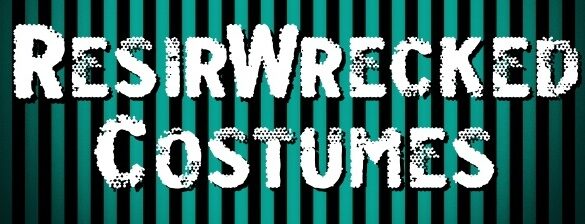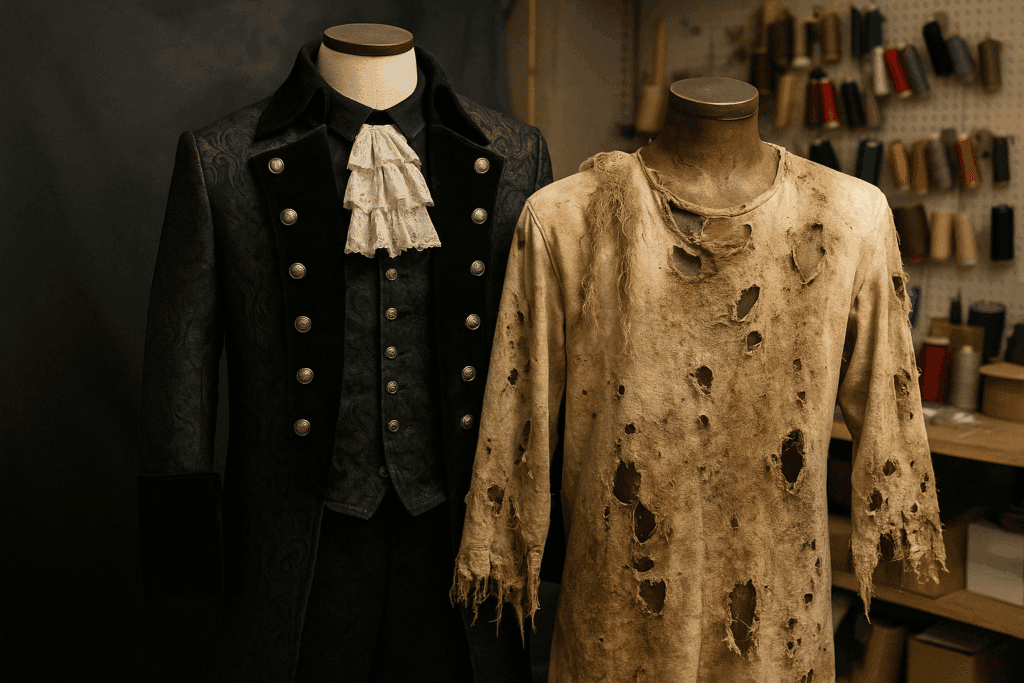In the world of haunted attractions, costume design isn’t just clothing—it’s character, credibility, and customer immersion. What your actors wear directly affects your guests’ suspension of disbelief, and their experience depends on every last texture, stain, and stitch.
As a designer with a background in both professional theatre and theme park entertainment, I frequently consult with attraction owners weighing their options:
Should I invest in custom-made costumes for my haunt, or buy mass-market and send them out for a break-down treatment?
The answer isn’t one-size-fits-all—but it does require transparency and intention.
Let’s break it down.
(Yes, pun intended.)
What Is a “Break-Down Artist”?
In film, theatre, and themed entertainment, a break-down artist (or aging/distressing technician) is a professional who intentionally wears, stains, fades, and manipulates garments to make them appear aged, lived-in, or grotesque.
They take a brand-new shirt and make it look like it’s been buried in the woods for a week. They can turn pristine trousers into something that reads as “escaped the asylum with only one shoe.” This is an art form, and done well, it adds immense realism to your attraction.
A talented break-down artist can take store-bought garments and make them look immersive—when budget or quantity requires it.
Pros & Cons: Custom Costumes vs. Store-Bought + Break Down
Custom-Built Costumes
Pros:
-
Tailored to your specific characters, storyline, and movement needs
-
Built from performance-grade fabrics (durable, washable, breathable)
-
Designed with layering, harnesses, or prosthetics in mind
-
One-of-a-kind aesthetic = your brand stands out
-
Easily updated or modified over time
Cons:
-
Higher upfront cost
-
Longer lead time (especially in peak haunt season)
-
Requires detailed communication and creative collaboration
Store-Bought with Professional Break Down
Pros:
-
Faster turnaround if garments are in stock
-
More cost-effective for large casts or background performers
-
Paired with a skilled artist, can still look incredibly compelling
-
Easier to replace multiples of the same item
Cons:
-
Less unique—other haunts may be using the same base item
-
Lower quality fabrics and construction may not hold up to nightly wear
-
Fit and mobility may be compromised
-
Not always obvious to the customer what they’re paying for
Transparency Matters: Don’t Let Creative Shortcuts Turn Into Fraud
Here’s where we need to get serious.
There’s nothing wrong with using off-the-rack pieces—when the client knows. But when a costume designer or vendor passes off altered store-bought costumes as original designs (and charges accordingly), it crosses a line. This isn’t just an ethical gray area—it can potentially:
-
Violate intellectual property rights of other designers or brands
-
Damage the reputation of your haunt if the public recognizes mass-market pieces
-
Breach trust with your customers and producers
-
Mislead customers into paying custom rates for commercial alterations
A professional costume designer must be transparent about what is custom-built, what is modified retail, and what is distressed stock. Costumes should be priced accordingly, with honesty baked into every line item.
Final Thoughts: Which Should You Choose?
Here’s what I recommend:
-
Use custom costumes for your hero characters—those seen up-close, on marketing materials, or key to your storyline. Make them instagramable!
-
Use store-bought + break-down for secondary cast, crowd scenes, or interchangeable ensemble roles.
-
Always ask your costume provider what’s custom and what’s altered retail—and make sure that distinction is reflected in the quote.
Remember: your costumes are not just clothes. They are your narrative, your brand, and your promise to the audience. Whether you go custom, distressed, or somewhere in between—just be clear, be honest, and be intentional.
That’s how you build an event worth screaming about.


